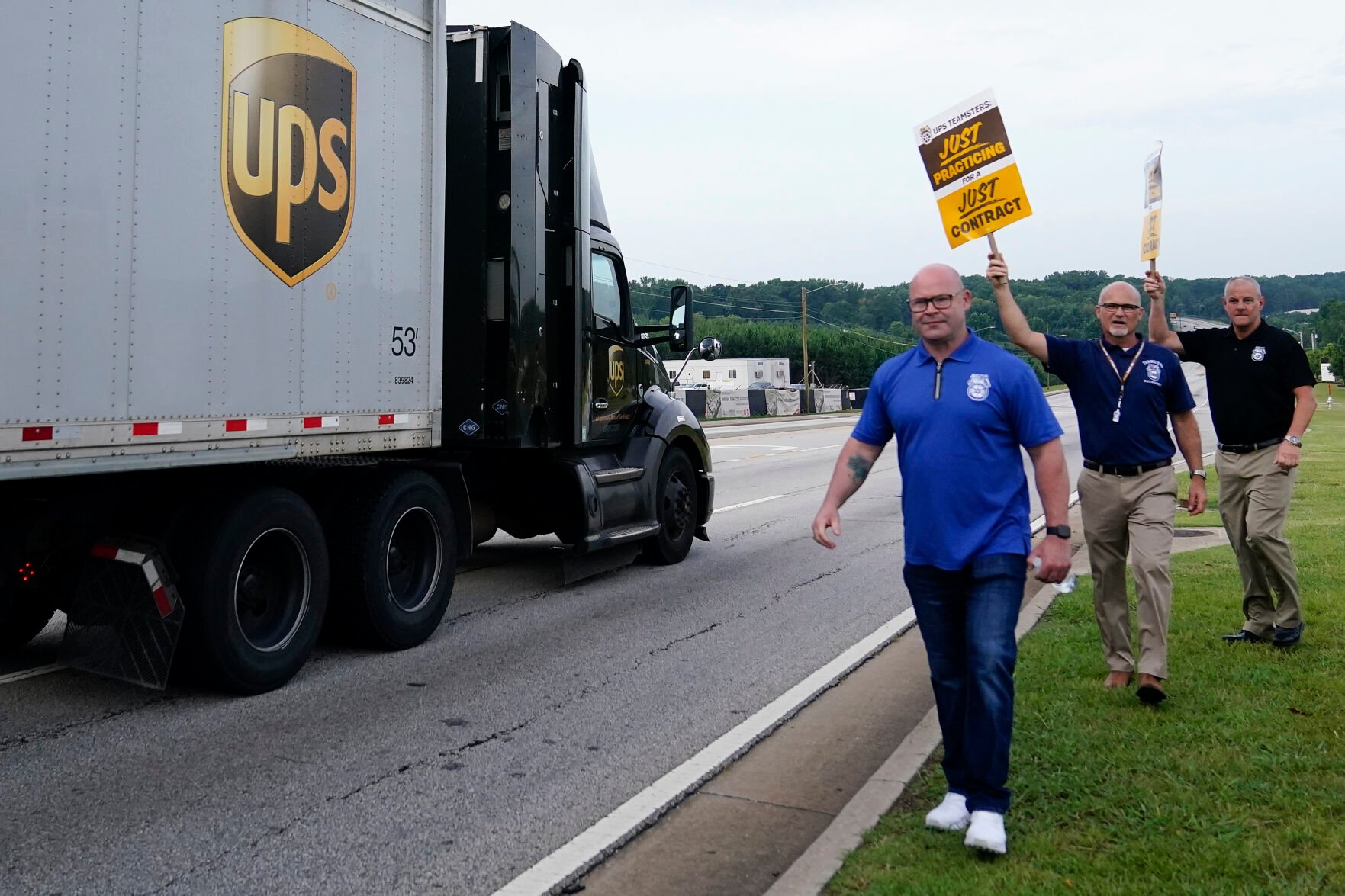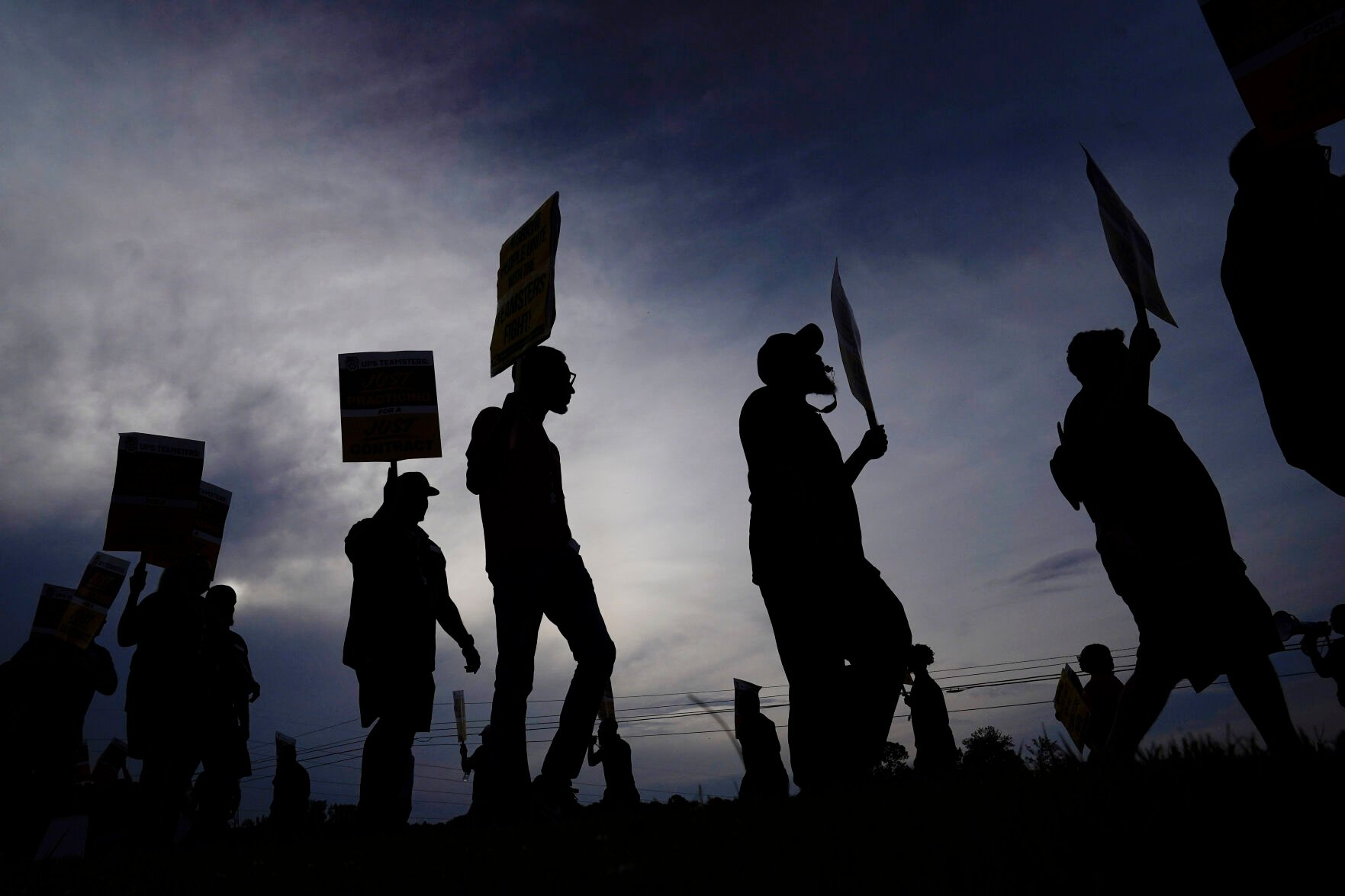NEW YORK — The clock is ticking. As the deadline to reach a new contract nears, a potential UPS strike feels closer than ever.
Negotiations broke down earlier this month and unionized workers have been holding rallies and practice pickets across the country. The Teamsters, which represent more than half of the company’s workforce, will resume talks with UPS on Tuesday.
That leaves less than a week to come to an agreement before the current contract expires on Monday, July 31. The union has authorized a strike and Sean M. O’Brien, a fiery leader elected last year to lead the union, has vowed to do so if their demands aren’t met.
“We’re sending a message… all 340,000 of our members are united and ready to fight,” O’Brien told The Associated Press at a practice picket Friday in Atlanta, where UPS is based.

Brynn Anderson
UPS teamsters and workers hold a rally, Friday, July 21, 2023, in Atlanta, as a national strike deadline nears. The Teamsters said Friday that they will resume contract negotiations with UPS, marking an end to a stalemate that began two weeks ago when both sides walked away from talks while blaming each other. (AP Photo/Brynn Anderson)
UPS’s unionized workers still seethe about a contract they feel was forced on them in 2018, and say that the company delivers millions more packages every day than it did just five years ago. The Teamsters are calling for better pay, particularly for part-time employees, and improved working conditions.
UPS has maintained that it already offers “industry-leading pay and benefits,” but says it’s prepared to increase that compensation. In a Friday update, the company said it aimed “quickly to finalize a fair deal that provides certainty for our customers, our employees and businesses across the country.”
If negotiations are unsuccessful the deliveries that Americans have come to rely on, particularly since the pandemic began in 2020, could be vastly disrupted. Such an impasse hasn’t been seen since 1997, well before delivery of everyday items from dog food to prescription drugs became the norm, when a walkout by 185,000 workers crippled UPS. Here’s what you need to know.

Brynn Anderson
A UPS truck drives by as Sean M. O'Brien, left, teamsters general president, UPS teamsters and workers hold a rally Friday, July 21, 2023, in Atlanta, as a national strike deadline nears. The Teamsters said Friday that they will resume contract negotiations with UPS, marking an end to a stalemate that began two weeks ago when both sides walked away from talks while blaming each other. (AP Photo/Brynn Anderson)
WHAT ARE THE TEAMSTERS ASKING FOR?
Much on the union’s demands comes down to better pay and improved working conditions.
Annual profits at UPS in the past two years are close to three times what they were before the pandemic. The company returned about $8.6 billion to shareholders in the form of dividends and stock buybacks in 2022, and forecast another $8.4 billion for shareholders this year.
The Teamsters say frontline UPS workers deserve some of that windfall. A sticking point in negotiations has been wage increases for part-time workers, who make a minimum of $16.20 an hour.
“People want their packages yesterday with the emergence of the e-commerce. So it’s a very demanding job,” O’Brien said, pushing back on the salary statistics that UPS shares. “Everybody doesn’t realize what it takes to get these packages on the truck. And a lot of our part timers… work for poverty wages.”
In addition to addressing part-time pay, the union wants to eliminate a contract provision that created two separate hierarchies of workers with different pay scales, hours and benefits. Driver safety, particularly the lack of air conditioning in delivery trucks, is also in the mix.

Brynn Anderson
UPS teamsters and workers wait before a rally, Friday, July 21, 2023, in Atlanta, as a national strike deadline nears. The Teamsters said Friday that they will resume contract negotiations with UPS, marking an end to a stalemate that began two weeks ago when both sides walked away from talks while blaming each other. (AP Photo/Brynn Anderson)
HAS UPS AGREED TO ANY DEMANDS?
Before contract talks broke down on July 5, with both sides blaming each other for walking away from the bargaining table, tentative agreements were made on several issues — including installing air conditioning in more trucks. UPS said it would add air conditioning to U.S. small delivery vehicles purchased after January 1, 2024. Existing vehicles wouldn’t get that upgrade, but the union said they will have other additions like fans and air vents.
The union also said it has reached tentative agreements to establish Martin Luther King Jr. Day as a full holiday for the first time, end unwanted overtime on drivers’ days off and get rid of the two-tier wage system for drivers who work weekends and earn less money.

Brynn Anderson
UPS teamsters and workers hold a rally, Friday, July 21, 2023, in Atlanta, as a national strike deadline nears. The Teamsters said Friday that they will resume contract negotiations with UPS, marking an end to a stalemate that began two weeks ago when both sides walked away from talks while blaming each other. (AP Photo/Brynn Anderson)
COULD A STRIKE BE AVOIDED? CAN THE GOVERNMENT INTERVENE?
The strike can be avoided if UPS and the Teamsters agree to a new contract before the July 31 deadline. There’s also a possibility of government intervention.
O’Brien said Sunday that he has asked the White House on numerous occasions not to intervene if workers end up going on strike. Last year, President Joe Biden intervened to avert a railroad strike to avoid disrupting the nation’s supply chain, and workers had accept an agreement that wasn’t broadly supported by union members.

Brynn Anderson
UPS teamsters and workers wait before a rally, Friday, July 21, 2023, in Atlanta, as a national strike deadline nears. The Teamsters said Friday that they will resume contract negotiations with UPS, marking an end to a stalemate that began two weeks ago when both sides walked away from talks while blaming each other. (AP Photo/Brynn Anderson)
WHAT IMPACT WOULD A STRIKE HAVE?
The 24 million packages UPS ships on an average day amounts to about a quarter of all U.S. parcel volume, according to the global shipping and logistics firm Pitney Bowes. As UPS puts it, that’s the equivalent of about 6% of nation’s gross domestic product.
Higher prices and long wait times are all but certain if there is an impasse. A strike also threatens to extend lingering supply chain troubles.
“Something’s got to give,” Thomas Goldsby, logistics chairman in the Supply Chain Management Department at the University of Tennessee, told The Associated Press. “The python can’t swallow the alligator, and that’s going to be felt by all of us.”
UPS said this month that it will temporarily begin training nonunion employees in the U.S. to step in should there be a strike.
Beyond shipping and supply implications, a union win at UPS could have significance for organized labor across industries. UPS’s contract talks arrive amid other prominent labor campaigns at Apple, Starbucks, Trader Joe’s and other companies — as well as the current writers and actors’ strikes seen in Hollywood.
_______
-
Late-night TV shows go dark as writers strike for better pay
Billion Photos
Photo Credit: Billion Photos / Shutterstock
After decades of declining power and influence, organized labor in the U.S. is making a comeback.
The COVID-19 pandemic has set off a number of shifts in the labor market that have given workers more power. Labor participation rates fell sharply early in the pandemic and still have not recovered to pre-pandemic levels. The Great Resignation saw millions of workers leave their jobs in search of better pay or working conditions. With the labor market still tight, employers have struggled to recruit and retain employees.
In this context, workers have been organizing at rates not seen in decades. One of the most high-profile examples is the union drive at Starbucks stores across the U.S. over the last year. Around 250 Starbucks locations have voted to unionize since the first Starbucks union formed in Buffalo, NY late in 2021. Employees at other major companies have also attempted unionization, including retail and factory workers at Apple and Amazon. And the trend extends to white collar industries like tech, academia, and media, where unionization has historically been limited.
According to the National Labor Relations Board, 1,522 votes on unionization have taken place so far in 2022. This is the highest number of union elections since 2015 and an increase of more than 50% over 2021.
Billion Photos
Photo Credit: Billion Photos / Shutterstock
After decades of declining power and influence, organized labor in the U.S. is making a comeback.
The COVID-19 pandemic has set off a number of shifts in the labor market that have given workers more power. Labor participation rates fell sharply early in the pandemic and still have not recovered to pre-pandemic levels. The Great Resignation saw millions of workers leave their jobs in search of better pay or working conditions. With the labor market still tight, employers have struggled to recruit and retain employees.
In this context, workers have been organizing at rates not seen in decades. One of the most high-profile examples is the union drive at Starbucks stores across the U.S. over the last year. Around 250 Starbucks locations have voted to unionize since the first Starbucks union formed in Buffalo, NY late in 2021. Employees at other major companies have also attempted unionization, including retail and factory workers at Apple and Amazon. And the trend extends to white collar industries like tech, academia, and media, where unionization has historically been limited.
According to the National Labor Relations Board, 1,522 votes on unionization have taken place so far in 2022. This is the highest number of union elections since 2015 and an increase of more than 50% over 2021.
-
Late-night TV shows go dark as writers strike for better pay
The recent uptick in unionization could begin to reverse a decades-long decline in union membership rates. The peak of union membership over the last 50 years was in 1979, when 24.1% of American workers were union members. That figure has since fallen by more than half, with only 10.3% of workers in a union as of 2021. In raw numbers, there are nearly 7 million fewer union members in the U.S. now than there were in the late 1970s.
Recent trends in unionization are significant to bother workers and employers. Unionization and collective bargaining materially affect the compensation and working conditions that workers experience, for better or for worse. In turn, these factors can affect employers’ ability to staff their businesses and the overhead costs they must pay to operate.
The recent uptick in unionization could begin to reverse a decades-long decline in union membership rates. The peak of union membership over the last 50 years was in 1979, when 24.1% of American workers were union members. That figure has since fallen by more than half, with only 10.3% of workers in a union as of 2021. In raw numbers, there are nearly 7 million fewer union members in the U.S. now than there were in the late 1970s.
Recent trends in unionization are significant to bother workers and employers. Unionization and collective bargaining materially affect the compensation and working conditions that workers experience, for better or for worse. In turn, these factors can affect employers’ ability to staff their businesses and the overhead costs they must pay to operate.
-
-
Late-night TV shows go dark as writers strike for better pay
Compensation is one of the most notable differences between unionized and non-unionized workers, as unions are often able to negotiate for higher wages. And as unions’ influence has declined over time, so too has the gap in compensation between union and non-union employee wages. At the height of unionization in the late 1970s and early 1980s, union members made over 30% more per hour than their non-union counterparts. Today, union members continue to earn more than non-union workers, but the gap between the two is just 11%.
The new growth in union membership is unlikely to return the U.S. to historic levels of unionization, and union representation will continue to be stronger in some industries than others. Certain sectors of the economy have significantly higher rates of union membership than others, including transportation, utilities, public administration, and education. At the highest end, some industries have union membership rates greater than 50%.
The data used in this analysis is from Unionstats.com. Researchers at Smartest Dollar calculated the union membership rate for 247 industries, ranking them from highest to lowest. In the event of a tie, the industry with the greater union coverage rate was ranked higher.
Here are the most unionized industries.
Compensation is one of the most notable differences between unionized and non-unionized workers, as unions are often able to negotiate for higher wages. And as unions’ influence has declined over time, so too has the gap in compensation between union and non-union employee wages. At the height of unionization in the late 1970s and early 1980s, union members made over 30% more per hour than their non-union counterparts. Today, union members continue to earn more than non-union workers, but the gap between the two is just 11%.
The new growth in union membership is unlikely to return the U.S. to historic levels of unionization, and union representation will continue to be stronger in some industries than others. Certain sectors of the economy have significantly higher rates of union membership than others, including transportation, utilities, public administration, and education. At the highest end, some industries have union membership rates greater than 50%.
The data used in this analysis is from Unionstats.com. Researchers at Smartest Dollar calculated the union membership rate for 247 industries, ranking them from highest to lowest. In the event of a tie, the industry with the greater union coverage rate was ranked higher.
Here are the most unionized industries.
-
Late-night TV shows go dark as writers strike for better pay
Andrey Armyagov
Photo Credit: Andrey Armyagov / Shutterstock
- Union membership rate: 25.0%
- Union coverage rate: 28.1%
- Total union membership: 138,656
- Total union coverage: 156,072
- Sector: Public Administration
Andrey Armyagov
Photo Credit: Andrey Armyagov / Shutterstock
- Union membership rate: 25.0%
- Union coverage rate: 28.1%
- Total union membership: 138,656
- Total union coverage: 156,072
- Sector: Public Administration
-
-
Late-night TV shows go dark as writers strike for better pay
Sergey Nemirovsky
Photo Credit: Sergey Nemirovsky / Shutterstock
- Union membership rate: 25.1%
- Union coverage rate: 26.1%
- Total union membership: 47,959
- Total union coverage: 49,928
- Sector: Nondurable Goods Manufacturing
Sergey Nemirovsky
Photo Credit: Sergey Nemirovsky / Shutterstock
- Union membership rate: 25.1%
- Union coverage rate: 26.1%
- Total union membership: 47,959
- Total union coverage: 49,928
- Sector: Nondurable Goods Manufacturing
-
Late-night TV shows go dark as writers strike for better pay
Viewfoto studio
Photo Credit: Viewfoto studio / Shutterstock
- Union membership rate: 25.2%
- Union coverage rate: 28.8%
- Total union membership: 76,932
- Total union coverage: 88,138
- Sector: Public Administration
Viewfoto studio
Photo Credit: Viewfoto studio / Shutterstock
- Union membership rate: 25.2%
- Union coverage rate: 28.8%
- Total union membership: 76,932
- Total union coverage: 88,138
- Sector: Public Administration
-
-
Late-night TV shows go dark as writers strike for better pay
Zivica Kerkez
Photo Credit: Zivica Kerkez / Shutterstock
- Union membership rate: 25.6%
- Union coverage rate: 25.6%
- Total union membership: 29,094
- Total union coverage: 29,094
- Sector: Utilities
Zivica Kerkez
Photo Credit: Zivica Kerkez / Shutterstock
- Union membership rate: 25.6%
- Union coverage rate: 25.6%
- Total union membership: 29,094
- Total union coverage: 29,094
- Sector: Utilities
-
Late-night TV shows go dark as writers strike for better pay
mavo
Photo Credit: mavo / Shutterstock
- Union membership rate: 26.2%
- Union coverage rate: 29.5%
- Total union membership: 332,403
- Total union coverage: 373,761
- Sector: Public Administration
mavo
Photo Credit: mavo / Shutterstock
- Union membership rate: 26.2%
- Union coverage rate: 29.5%
- Total union membership: 332,403
- Total union coverage: 373,761
- Sector: Public Administration
-
-
Late-night TV shows go dark as writers strike for better pay
People Image Studio
Photo Credit: People Image Studio / Shutterstock
- Union membership rate: 26.4%
- Union coverage rate: 28.0%
- Total union membership: 30,428
- Total union coverage: 32,259
- Sector: Utilities
People Image Studio
Photo Credit: People Image Studio / Shutterstock
- Union membership rate: 26.4%
- Union coverage rate: 28.0%
- Total union membership: 30,428
- Total union coverage: 32,259
- Sector: Utilities
-
Late-night TV shows go dark as writers strike for better pay
Shutterstock
Photo Credit: Feoktistoff / Shutterstock
- Union membership rate: 27.2%
- Union coverage rate: 33.0%
- Total union membership: 90,118
- Total union coverage: 109,429
- Sector: Public Administration
Shutterstock
Photo Credit: Feoktistoff / Shutterstock
- Union membership rate: 27.2%
- Union coverage rate: 33.0%
- Total union membership: 90,118
- Total union coverage: 109,429
- Sector: Public Administration
-
-
Late-night TV shows go dark as writers strike for better pay
DedMityay
Photo Credit: DedMityay / Shutterstock
- Union membership rate: 29.5%
- Union coverage rate: 29.5%
- Total union membership: 15,053
- Total union coverage: 15,053
- Sector: Durable Goods Manufacturing
DedMityay
Photo Credit: DedMityay / Shutterstock
- Union membership rate: 29.5%
- Union coverage rate: 29.5%
- Total union membership: 15,053
- Total union coverage: 15,053
- Sector: Durable Goods Manufacturing
-
Late-night TV shows go dark as writers strike for better pay
Shutterstock
Photo Credit: ersin ergin / Shutterstock
- Union membership rate: 38.4%
- Union coverage rate: 40.2%
- Total union membership: 231,414
- Total union coverage: 242,337
- Sector: Transportation & Warehousing
Shutterstock
Photo Credit: ersin ergin / Shutterstock
- Union membership rate: 38.4%
- Union coverage rate: 40.2%
- Total union membership: 231,414
- Total union coverage: 242,337
- Sector: Transportation & Warehousing
-
-
Late-night TV shows go dark as writers strike for better pay
Shutterstock
Photo Credit: Ground Picture / Shutterstock
- Union membership rate: 39.1%
- Union coverage rate: 43.6%
- Total union membership: 3,457,197
- Total union coverage: 3,862,835
- Sector: Educational Services
Shutterstock
Photo Credit: Ground Picture / Shutterstock
- Union membership rate: 39.1%
- Union coverage rate: 43.6%
- Total union membership: 3,457,197
- Total union coverage: 3,862,835
- Sector: Educational Services
-
Late-night TV shows go dark as writers strike for better pay
Shutterstock
Photo Credit: LightField Studios / Shutterstock
- Union membership rate: 40.9%
- Union coverage rate: 43.2%
- Total union membership: 1,093,245
- Total union coverage: 1,153,724
- Sector: Public Administration
Shutterstock
Photo Credit: LightField Studios / Shutterstock
- Union membership rate: 40.9%
- Union coverage rate: 43.2%
- Total union membership: 1,093,245
- Total union coverage: 1,153,724
- Sector: Public Administration
-
-
Late-night TV shows go dark as writers strike for better pay
LeManna
Photo Credit: LeManna / Shutterstock
- Union membership rate: 42.5%
- Union coverage rate: 43.5%
- Total union membership: 190,016
- Total union coverage: 194,251
- Sector: Transportation & Warehousing
LeManna
Photo Credit: LeManna / Shutterstock
- Union membership rate: 42.5%
- Union coverage rate: 43.5%
- Total union membership: 190,016
- Total union coverage: 194,251
- Sector: Transportation & Warehousing
-
Late-night TV shows go dark as writers strike for better pay
Ryan DeBerardinis
Photo Credit: Ryan DeBerardinis / Shutterstock
- Union membership rate: 54.0%
- Union coverage rate: 56.8%
- Total union membership: 107,632
- Total union coverage: 113,299
- Sector: Transportation & Warehousing
Ryan DeBerardinis
Photo Credit: Ryan DeBerardinis / Shutterstock
- Union membership rate: 54.0%
- Union coverage rate: 56.8%
- Total union membership: 107,632
- Total union coverage: 113,299
- Sector: Transportation & Warehousing
-
-
Late-night TV shows go dark as writers strike for better pay
Drazen Zigic
Photo Credit: Drazen Zigic / Shutterstock
- Union membership rate: 58.8%
- Union coverage rate: 64.1%
- Total union membership: 369,623
- Total union coverage: 403,417
- Sector: Transportation & Warehousing
Drazen Zigic
Photo Credit: Drazen Zigic / Shutterstock
- Union membership rate: 58.8%
- Union coverage rate: 64.1%
- Total union membership: 369,623
- Total union coverage: 403,417
- Sector: Transportation & Warehousing
-
Late-night TV shows go dark as writers strike for better pay
Billion Photos
Photo Credit: Billion Photos / Shutterstock
- Union membership rate: 65.0%
- Union coverage rate: 67.0%
- Total union membership: 52,163
- Total union coverage: 53,821
- Sector: Other Services, Exc. Public Admin.
Billion Photos
Photo Credit: Billion Photos / Shutterstock
- Union membership rate: 65.0%
- Union coverage rate: 67.0%
- Total union membership: 52,163
- Total union coverage: 53,821
- Sector: Other Services, Exc. Public Admin.





